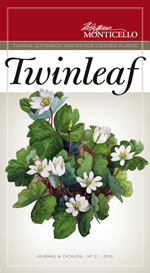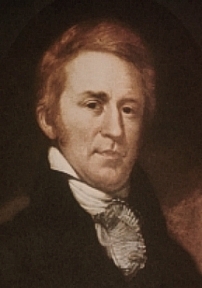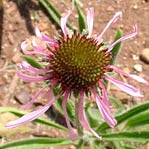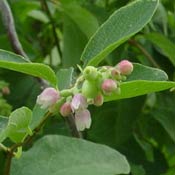
In his first inaugural address in 1801 Jefferson envisioned, "A rising nation, spread over a wide and fruitful land, advancing rapidly to destinies beyond the reach of mortal eye." Less than two years later, on January 18, 1803, he delivered a confidential message to Congress outlining a plan for exploring to the "Western Ocean," and requesting an appropriation of $2,500 for what would become the Lewis and Clark Expedition. 2003 marks the 200th anniversary of this letter, and, beginning on January 18, 2003, Monticello will serve as the kick-off headquarters for a commemoration of this pivotal journey in American history.
Jefferson described botany as "among the most useful of the sciences," and wrote that, "No country gentleman should be without what amuses every step he takes into his fields." Jefferson himself went on botanical rambles as far away as upstate New York, compiled an abbreviated flora of Virginia in his only published book, Notes on the State of Virginia, and owned over thirty books on botany. He used the science of botany not so much as a taxonomist or field botanist with a hand lens for study, but rather, Jefferson was fascinated by the practical applications to which the botanical world could be used. For example, in his Notes, he organized Virginia's native flora into four categories according to their function: "Medicinal," "Esculent [or edible]," "Ornamental," or "Useful for fabrication." One might describe Jefferson as a "hortobotanist" in the way he aspired to exploit the botanical world for useful and horticultural purposes.

Botanical discovery was one of the key goals of the Lewis and Clark Corps of Discovery. Meriwether Lewis, before setting out on the expedition in May 1803, went to Philadelphia to learn from such notable American scientists as the astronomer Andrew Ellicot, Benjamin Rush, the physician; and Caspar Wister, the premier anatomist of the time. Lewis also studied under Benjamin S. Barton, highly esteemed professor of botany at the University of Pennsylvania. From him Lewis learned how to collect and properly dry specimens, and received an introduction to taxonomic botany. Lewis's expedition journals included some 200 technical botanical terms. Although he also bought (for $6) and took with him the first American botanical textbook, Barton's Elements of Botany, as well as works by Carl Linnaeus, Lewis often described West Coast species by their similarity to those on the East Coast, and he never used Linnaean binomial nomenclature. Lewis already possessed a "native" awareness of plants; his mother was an "herb doctor" in Albemarle County, Virginia, and, like Jefferson, Meriwether Lewis perceived plants by how they could be used, rather than for their intrinsic scientific value.
Dried botanical specimens from the expedition returned east in two different shipments. Over 100 were sent to President Jefferson in spring of 1805 from their winter quarters at Fort Mandan; Lewis brought back the rest in 1807. Jefferson, who once claimed that, "the greatest service which can rendered any country is to add a useful plant to its culture," was probably more excited by the expedition's plant discoveries that held some garden significance. This was at a time when most skilled gardeners involved with the expedition - Bernard McMahon, William Hamilton, and John Lyon - were talented botanists. Conversely, the noted botanists involved with the taxonomic analysis - Benjamin Smith Barton and Frederick Pursh - were experienced horticulturists. This union of horticulture and botany is rare today, yet it was a fundamental theme at the heart of the expedition: how could these new plants be grown and used?
Osage orange (Maclura pomifera), a tree species native to the southern Mississippi valley, might have been the most significant horticultural "discovery" of the expedition. Meriwether Lewis sent "some slips of the Osage Plums, and Apples" to Jefferson on March 26, 1804 from a garden in St. Louis owned by Pierre Choteau. On his return journey in 1807, Lewis collected seeds from the same but more mature specimen, finally bearing seeds after three vegetative seasons, and personally brought them back to Washington and Philadelphia. These were distributed to Philadelphia nurseryman Bernard McMahon and wealthy plantsman William Hamilton, and were successfully grown and distributed.
17th-century French explorers described the tree as 'bois d'arc' or bow wood, a term later corrupted by the Americans to "Bodark." Native American Indians exploited the exceptional strength and elasticity of the wood for tomahawks and especially bows. One Osage bow was worth a horse and blanket in trade. The convoluted, grapefruit-sized fruit of the female trees, formidable thorns on young shoots, yellow-colored bark, and lush, healthy foliage distinguish this tree. Robert Carr, proprietor of Bartram's Garden in Philadelphia, was one of the tree's first commercial sources in 1828, but by the mid 19th century it became the most commonly planted plant in America. Osage orange can be sheared effectively into impenetrable hedges, and 60,000 miles of bodark hedging were reportedly planted in 1868 alone. The invention of barbed wire soon made Osage orange hedges less desirable.
As the expedition traveled north along the Missouri River in fall 1805, they encountered the Mandan, Arikara, and Hidatsa tribes. Their horticulture, based on the cultivation of bean, corn, and squash varieties that thrived in the severe climate of the northern Plains, was perhaps the most evolved of all North American Indian tribes. The Mandan villages, depicted so vividly by the landscape artist, George Catlan, in the 1830s, were along the bluffs of the Missouri north of what is today Bismarck, North Dakota. Here, the expedition constructed Fort Mandan and spent the harsh winter of 1805, with temperatures averaging 4° and plummeting to -45°F. As supplies of buffalo and deer meat diminished, the corps was sustained through the trading of corn. According to popular historian, Stephen Ambrose, "It was Mandan corn that got the men through the winter."
Mandan gardens were along the river bottoms, averaged about a ¼ acre in size, and were cared for by the women. Gardens would often be moved after exhausting soil and they were seldom cultivated; it was considered a violation to plow or dig up the earth. Garden debris was grazed by horses in fall, and then raked away in spring for planting. Animal manure was considered "unclean." Tools came from animal parts - deer antlers were used as rakes and bison bones as hoes. Half of their subsistence and economy was based on cultivated vegetable varieties that had been developed for the cold weather, short season (90 days), and limited rainfall (10 inches a year). As early as 1729, Mandan villages held harvest-time markets for both European and Indian bartering, attracting consumers from as far away as the Great Lakes and Rocky Mountains.
 On April 7, 1805, Meriwether Lewis sent from Fort Mandan to President Jefferson a shipment of Indian artifacts, animal specimens, a "carrot" of tobacco, a Mandan buffalo robe, and some 198 dried botanical specimens. While the botanical specimens were shipped to Benjamin S. Barton, long presumed to be the official botanist of the journey, and the Indian artifacts forwarded to the American Philosophical Society, the seed of the Mandan tobacco was sent to Philadelphia plantsman William Hamilton, whose estate, the Woodlands was, according to Jefferson, "the only rival which I have known in America to what may be seen in England." Jefferson, who believed tobacco culture was "productive of infinite wretchedness," described the Mandan tobacco as "a singular species, uncommonly weak & probably suitable for segars." Unlike food crops, which were tended by Native American women, tobacco was grown by men and used ritualistically in ceremonial gatherings. Mandan tobacco, Nicotiana quadrivalvis var. quadrivalvis, is native to northern California and Oregon. It is thought to be extinct in both the wild and in cultivation; however, we obtained seeds in 2002 from Joseph Winter of the Native American Plant Cooperative in Albuquerque, New Mexico, and grew it in a Lewis and Clark demonstration plot in the Monticello kitchen garden.
On April 7, 1805, Meriwether Lewis sent from Fort Mandan to President Jefferson a shipment of Indian artifacts, animal specimens, a "carrot" of tobacco, a Mandan buffalo robe, and some 198 dried botanical specimens. While the botanical specimens were shipped to Benjamin S. Barton, long presumed to be the official botanist of the journey, and the Indian artifacts forwarded to the American Philosophical Society, the seed of the Mandan tobacco was sent to Philadelphia plantsman William Hamilton, whose estate, the Woodlands was, according to Jefferson, "the only rival which I have known in America to what may be seen in England." Jefferson, who believed tobacco culture was "productive of infinite wretchedness," described the Mandan tobacco as "a singular species, uncommonly weak & probably suitable for segars." Unlike food crops, which were tended by Native American women, tobacco was grown by men and used ritualistically in ceremonial gatherings. Mandan tobacco, Nicotiana quadrivalvis var. quadrivalvis, is native to northern California and Oregon. It is thought to be extinct in both the wild and in cultivation; however, we obtained seeds in 2002 from Joseph Winter of the Native American Plant Cooperative in Albuquerque, New Mexico, and grew it in a Lewis and Clark demonstration plot in the Monticello kitchen garden.
The 1805 shipment also included a specimen of the "Mad Dog Plant," described as "highly prized by the natives as an efficacious remedy in the cure of the bite of the rattle snake, or mad dog . . ." This plant is the narrow-leaved or plains coneflower, Echinacea angustifolia, which was not technically described until 1836. The plains coneflower differs from the more commonly cultivated Echinacea purpurea because of its reflexed purple flowers and tap root, making it somewhat more difficult to transplant but just as heat and drought resistant.
Lewis brought seeds of the most promisingly practical plants to President Jefferson in 1807. Jefferson retained some varieties, but forwarded most of the seeds to more skilled horticulturists like McMahon and Hamilton. Jefferson sowed the Arikara bean at Monticello in 1809, and recorded that this "very forward" (early ripening) variety came to table July 1 as a fresh snap bean. He continued growing "Ricara" or Arikara bean in 1811 and noted that it "is one of the most excellent we have had," but he concluded, "I have one kind only superior to them, but being very sensibly so, I shall abandon the Ricaras." Such was the nature of Jefferson's experimental garden laboratory at Monticello. The McMahon's 1815 nursery catalog offered Arikara beans among the first commercial selections of the Lewis and Clark horticultural collection. Jefferson also experimented with wild salsify collected along the journey. This "Missouri" or "Columbian" salsify was similarly abandoned after being planted at Monticello between 1807 and 1812.
 "Pani" or Pawnee corn, named for the southern neighbors of the Mandan and Arikara, was planted eight times among the fruit trees in the South Orchard and was Jefferson's favorite of the Indian corn varieties collected on the journey. A dwarf corn, only 24-inches high, bred for the severity of the short northern Plains growing season, Pani ripened as quickly as six weeks from planting. Jefferson compared it favorably to the short season Quarantine (or "40 day") corn he received from André Thoüin of the Jardin des Plantes in Paris. The controversial German botanist, Frederick Pursh, who first published the botanical results of the expedition in his Flora Americae Septentrionalis of 1814, wrote that, "it produced as excellent ears as any sort I know." A similarly dwarf variety, perhaps identical, Mandan corn, was sold by McMahon in 1815.
"Pani" or Pawnee corn, named for the southern neighbors of the Mandan and Arikara, was planted eight times among the fruit trees in the South Orchard and was Jefferson's favorite of the Indian corn varieties collected on the journey. A dwarf corn, only 24-inches high, bred for the severity of the short northern Plains growing season, Pani ripened as quickly as six weeks from planting. Jefferson compared it favorably to the short season Quarantine (or "40 day") corn he received from André Thoüin of the Jardin des Plantes in Paris. The controversial German botanist, Frederick Pursh, who first published the botanical results of the expedition in his Flora Americae Septentrionalis of 1814, wrote that, "it produced as excellent ears as any sort I know." A similarly dwarf variety, perhaps identical, Mandan corn, was sold by McMahon in 1815.
The "flowering pea of the plains of Arkansas," or "Governor Lewis' pea" was successfully sown in a Monticello oval flower bed in April 1807, and seed was saved by Jefferson's granddaughter, Anne Randolph. Jefferson said it was "remarkable for its beautiful blossom & leaf," yet later relegated it to his South Orchard. The identity of this flowering pea is still a puzzle. Bernard McMahon identified is as a Lupinus, and, traditionally, Monticello gardeners have interpreted "Lewis' pea" as the highly ornamental Texas bluebonnet, Lupinus texensis. Paul Cutright, in Lewis and Clark, Pioneering Naturalist, identifies it as a type of purple vetch, Vicia americana, and this seems more likely given its wider native distribution.
Jefferson also planted the "Lilly. The yellow of the Columbia. Its root a food of the natives" in an oval bed in 1807. The yellow fritillary, or Fritillaria pudica, is a Liliaceous plant with edible fruits and was collected near the headwaters of the Missouri River. It grows throughout the Pacific Northwest in well-drained, dry, sunny sites, and is today a valued rock garden species for its nodding, golden-yellow flowers, and petite habit. Jefferson's seeds failed to germinate, according to his granddaughter, and it is generally difficult to grow in the humid east.
Because Jefferson was still President in 1807, and "in too indifferent a situation to take the care of them which they merit," he sent the remaining seeds of these "public treasures," mostly shrubs, to McMahon and Hamilton for propagation. Upon receiving the package, McMahon could hardly contain his excitement; he remarked that he had never seen seeds in a "better state of preservation" and that he would "be able to send you in due time, plants of every kind committed to my care."
McMahon's enthusiasm continued over the next two years as the Meriwether Lewis seeds responded to his care, and he could report to Jefferson "that I have fine plants of all varieties of Currants (7) and Gooseberries (2) brought by Governor Lewis, and of about 20 other new species of plants, as well as five or six genera." Before Lewis' untimely and mysterious death in 1809, McMahon became "very anxious" about the fate of his plants, which were quarantined to avoid falling "into the hands of any Botanist who might rob Mr. Lewis of the right he had to first describe and name his own discoveries." Complicating the issue was the presence of German botanist Frederick Pursh, who was then living at McMahon's while describing and illustrating the garden treasures McMahon had propagated, as well as the dried specimens collected on the journey. Soon after Lewis' sudden and mysterious death, Pursh left McMahon's lodgings with a significant collection of the dried specimens, which he later described and published in England in 1814. "Scissoring" samples of these precious dried specimens and then whisking them away without any official permission, incited the resentment of nationalistic American natural historians during the War of 1812. Jealous rivalry reined among competing botanists in this dramatic chapter of our botanical history. Ultimately, Pursh's Flora included ample acknowledgement of the personal "discoveries" of Lewis and Clark: he created two new genera, Lewisia and Clarkia, named three new species after Lewis, and included 13 illustrations of expedition plants in his publication.
 Although McMahon claimed to be growing some "25 species" in his garden, only three were shipped to Monticello in 1812. The yellow currant, Ribes aureum, was labeled as the "yellow currant of the river Jefferson" and it flourished in the South Orchard berry squares. McMahon described the other currant, Ribes odoratum, as "an important shrub, the fruit very large, of a dark purple colour, the flowers yellow, showey, & extremely fragrant." Jefferson planted it in "boxes" and in the berry squares, where it also thrived. Ribes odoratum was sold as early as 1811 by the Landreth Nursery in Philadelphia when, curiously, the Lewis and Clark plants were supposed to be quarantined in McMahon's garden. The sweet-scented currant, which, botanically, may be a variety of the yellow currant, was the most commonly sold Lewis and Clark woody plant in America before 1830: offered by McMahon in 1820, William Prince in 1822, and the Bartram Nursery in 1828.
Although McMahon claimed to be growing some "25 species" in his garden, only three were shipped to Monticello in 1812. The yellow currant, Ribes aureum, was labeled as the "yellow currant of the river Jefferson" and it flourished in the South Orchard berry squares. McMahon described the other currant, Ribes odoratum, as "an important shrub, the fruit very large, of a dark purple colour, the flowers yellow, showey, & extremely fragrant." Jefferson planted it in "boxes" and in the berry squares, where it also thrived. Ribes odoratum was sold as early as 1811 by the Landreth Nursery in Philadelphia when, curiously, the Lewis and Clark plants were supposed to be quarantined in McMahon's garden. The sweet-scented currant, which, botanically, may be a variety of the yellow currant, was the most commonly sold Lewis and Clark woody plant in America before 1830: offered by McMahon in 1820, William Prince in 1822, and the Bartram Nursery in 1828.
While traversing the rugged Bitterroot Mountains of Idaho, Meriwether Lewis encountered "a kind of honeysuckle which bears a white bury and rises about 4 feet high." McMahon gave the Symphoricarpus albus its common name, snowberry bush, and sent cuttings to Jefferson, noting the plants produced "some of the most beautiful berries I have ever seen." Jefferson grew it successfully and proudly passed cuttings to friends and neighbors as a botanical treasure of the expedition's success. To Madame de Tessé of Paris he described the snowberry as "an object as singular as it is beautiful." The snowberry, with its lush bluish-green foliage, unique alabaster berries which persist into the winter, and adaptability to use in the landscape, was also sold by the McMahon Nursery as early as 1815 and continues to the present as one of the significant horticultural legacies of the expedition.
The Lewis and Clark Expedition has been compared to the trip to the moon, but, surely, the Corps of Discovery harvested a far more magnificent bounty: the geography of soaring green mountains and immense golden plains; living collections of frightening wild animals and a treasure-trove of new plants; and startling artifacts of unique human cultures. The initial effort by Jefferson, McMahon, and others to introduce into cultivation the most promising plants discovered along the journey, unfortunately, was only mildly successful. The Osage orange, Linum lewisii, and snowberry soon became common horticultural additions to our gardens. The yellow currant was improved by Midwest fruit breeders late in the 19th century, but never became commercially viable. The Indian varieties of bean, corn, and squash - remarkable for their hardiness - added little to our cultivated seed bank and have been relatively ignored for their essential genetic possibilities. Other species, collected in the high Rockies or in the mild climatic Eden of the Pacific Northwest, were difficult, if not impossible, to grow in the gardens of eastern North America. Nonetheless, the marketing and distribution of the other Lewis and Clark discoveries, species new to science that they either collected as dried specimens or described for the first time, occurred gradually as other plant explorers "rediscovered" them through the 19th century.
Peter J. Hatch
Director, Gardens and Grounds
2003
